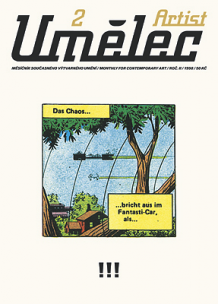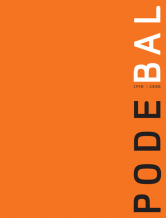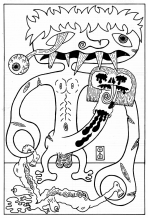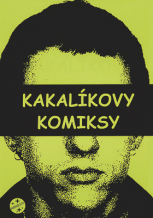| Revista Umělec 2005/2 >> On The Expulsion of The Friendless Warrior | Lista de todas las ediciones | ||||||||||||
|
|||||||||||||
On The Expulsion of The Friendless WarriorRevista Umělec 2005/201.02.2005 Travis Jeppesen | commentary | en cs de |
|||||||||||||
|
Why do we read art magazines? Sorry, but it’s a question that needs to be asked every now and then, as the answer seems to change over time according to one’s position, status, and relationship to the rest of the so-called art world, if such a world actually exists. Do we read in search of some projection of our selves on the glossy pages? To keep abreast of the latest trends so we don’t feel left behind? And, when we finally reach the back pages, do we flip through or actually read them? Does anyone care anymore about what the critic has to say? Is there still such a thing as an independent critic, unaffiliated with any art institution?
These are the questions I inevitably wound up asking myself after reading the latest issue of BE Magazine, a slim journal published under the auspices of Berlin’s Kunstlerhaus Bethanien. Issue number eleven is dedicated to the theme of “Critique” and kicks off with Hanno Rauterberg’s compelling essay addressing the current crisis of criticism in art. Departing from the provocative statement that if art criticism were to fall completely silent, nothing would change, Rauterberg goes on to argue that criticism’s central tenet, to make a judgment, has become a thing of the past. While acknowledging that this “death of criticism” proclamation is nothing new, Rauterberg maintains that the crisis of criticism has led to self-abolition in favor of a “falsely understood desire” to be objective. Criticism, as a serious intellectual discipline, can’t afford to be objective, reasons Rauterberg; as soon as you lose the I, it is no longer criticism. As Leibniz taught, all perception is determined by the point of the perceiver. Criticism has been replaced by a new sort of art writing that is little more than propaganda for exhibitions and individual careers. Rauterberg’s essay brings up several good points. Why are there so many artists and so few critics these days? It used to be that a review could make or break an artist’s career. Not so anymore. Critics are simply not adorned with that sort of power. When evaluating the history of the 20th century, the critic emerges as an agent of Modernism. It is important to remember that it was actually a poet, Charles Baudelaire, who created the modern discipline of art criticism. Baudelaire, an artist himself, thus made criticism an art, by constantly questioning and re-evaluating his own principles. In America, there’s the famous example of Clement Greenberg, champion of the Abstract Expressionists, and his disciples, as well as the Australian expatriate Robert Hughes. Baudelaire, Greenberg, Hughes: three household names in the history of art critique. Is there any other living figure, besides stodgy old Hughes, whose name possesses such authority? This loss can be attributed not only to increasingly conservative attitudes in the field of publishing, but to the introduction of trans-disciplinary practices in the arts sector. Under the potentially illusory guise of freedom, there has been a complete breakdown in the definition of the term “art world professional,” to include a wider matrix of professional activity. Today’s critic is also a curator, a museum director, an editor, perhaps even a visual artist herself. How can this critic write a negative review of an exhibition at a gallery where she hopes to one day curate an exhibition? What Rauterberg is essentially proposing is the re-introduction of a more rigidly defined professional sector, as per the model evolved throughout the course of the Modern era. But another option would be to deny this “death of criticism,” and simply recommence our contribution to the continual evolution of this “lost” discipline. We can start by listening to some of the voices outside the narrow realm of official art discourse, and to integrate some of those renegade outsider voices into the artspeak that has been emerging since the dawn of conceptualism and has of late fallen into a completely false “specialized” (pseudo-) language rife with the sort of verbose inanities that so effectively exclude those un-savvy enough to challenge the art world’s web of hierarchical systems. Furthermore, instead of relying on these tired categorical contingencies, we should be working to develop new art languages that refute criticism’s traditional limitations (i.e. didacticism). Language is not a system of goals, not an end in itself, but a savage beast yearning to be set free – we must let go and allow this beast to roam about and possibly do some harm, possibly even devour the very principles that we hold most sacred, to the extent of erasing the very thing we wish to communicate. In short, the future will require the emergence of a new criticism that manages to maintain its edge while returning to its poetic origins. Perhaps this wild new fornication of raw language and raw philosophy will occur in a medium other than the written word; perhaps it will be activated digitally; perhaps it will resemble the wild illegible graffiti found in Cy Twombly’s paintings… The primary goal should be not to judge, nor to nurture (although it can do both), but to ultimately confound us, thus spurring a more active engagement with the art object through its mysterious anti-nature, thereby bringing us closer to the Truth, which is always synonymous with Confusion.
01.02.2005
Artículos recomendados
|
|||||||||||||
|
04.02.2020 10:17
Letošní 50. ročník Art Basel přilákal celkem 93 000 návštěvníků a sběratelů z 80 zemí světa. 290 prémiových galerií představilo umělecká díla od počátku 20. století až po současnost. Hlavní sektor přehlídky, tradičně v prvním patře výstavního prostoru, představil 232 předních galerií z celého světa nabízející umění nejvyšší kvality. Veletrh ukázal vzestupný trend prodeje prostřednictvím galerií jak soukromým sbírkám, tak i institucím. Kromě hlavního veletrhu stály za návštěvu i ty přidružené: Volta, Liste a Photo Basel, k tomu doprovodné programy a výstavy v místních institucích, které kvalitou daleko přesahují hranice města tj. Kunsthalle Basel, Kunstmuseum, Tinguely muzeum nebo Fondation Beyeler.
|






























 We Are Rising National Gallery For You! Go to Kyjov by Krásná Lípa no.37.
We Are Rising National Gallery For You! Go to Kyjov by Krásná Lípa no.37.
Comentarios
Actualmente no hay comentariosAgregar nuevo comentario